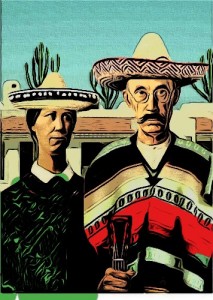While I was at the MALCS Summer Institute I confided in another attendee that I was nervous about the process of creating course syllabi as I’d never done it before. She, an associate professor of Spanish and all around lovely person, enthused that creating a syllabus was fun, and then told me she sometimes writes them to amuse herself.
With her words in mind, I tried to embrace this as an opportunity rather than something to fear. Sure enough, as I sat through the next talk, thinking about Chicana literature (I knew whatever course I came up with would be one focusing on Chicana/o literature), I came up with the idea of the “Chicana/o Gothic” — a course that would explore canonical and recent Chicana/o text through the dark lens of the gothic.
This is what I’ve come up with so far. I’d love to hear what you think — criticism is helpful. This version of the course is being imagined as one offered for a 10 week quarter. I’ve linked the texts I’ve reviewed to the reviews I’ve blogged.
Required Texts:
Bless Me Ultima – Rudolfo Anaya
Calligraphy of the Witch – Alicia Gaspar de Alba
Brides and Sinners in El Chuco – Christine Granados
The Cambridge Companion to Gothic Fiction – Jerrold E. Hogle
The Rain God – Arturo Islas
The Hungry Woman – Cherríe L. Moraga
What You See in the Dark – Manuel Munoz
Demon in the Mirror by by S. Joaquin Rivera
The Hummingbird’s Daughter – Luis Alberto Urea
Gods Go Begging – Alfredo VéaCourse Description
Is there a Chicana/o Gothic?What is called “Chicana/o literature” has many origins and forms and is itself a contested space — from the Chicana/o civil rights movement to the 1848 Treaty of Guadalupe Hidalgo to the pre-Columbian legends of Aztlán. Likewise, defining the “gothic” in literature encompasses literary periods and styles from the eighteenth through twenty-first centuries.
Gothic literature conveys a sense of uncertainty through bizarre twists, violence, and moral ambivalence to create suspense. Looking at Chicana/o texts, some recent, some canonical, can we see these techniques being used to explore the social, political, and racial issues of the Chicano community and Southwestern United States as the works move away from supernatural events and onto something which affects the reader’s state of mind regarding social issues and experience? Are Chicana/o novels and poems using elements of the horrific, the violent, the unorthodox, and/or the supernatural to guide the reader through the story’s action and explore anxieties about the instability of identity and nation? Is such a comparison between the gothic and the magical real useful to our understanding of Chicana/o literature as part of the larger U.S. literary canon? Drawing from constructions of the Southern Gothic and magical realism, what we may come to call “Chicano/a Gothic” is an attempt to discuss and define a Chicano/a and American sub-genre of gothic fiction.

I’d take that class. I think it’s funny what academics consider fun. Some of them/us can be such nerds.
I think your students will really enjoy The Hummingbird’s Daughter. It’s the book on your list that I’ve read most recently. It’d be interesting to contrast it with Bless Me Ultima. The latter was the first Chicano text I read in high school for honors English summer reading. I was enthralled by both the story and also because it was the first time I’d seen my people represented in literature.
Thank you and yes, I think we are nerds, in the best possible sense!
I just read Hummingbird’s Daughter and think it’d be great to teach it. Like you, I haven’t read Bless Me Ultima in a while, but I’m going to re-read it in the next few weeks. I remember it as beautiful.
I love it, Anne Perez! I’ll need to put my mente to it to offer you some helpful feedback – other than orale! – but it looks so fresh and you have some big libros on the list so it’s rigorous too. I love asking questions about Chicano/a lit from off to the side… Maybe we can talk vampiros sometime – but that’s more of a pretend class when I need a playful distraction – yours is going to happen!
Cheers are always welcome! I hope this class happens one day. Right now it’s an exercise for the job market, but the more I work on it, the more I want to teach it.
Let me know if you think of any feedback. I’m not fragile. (Much anyway. 🙂 )